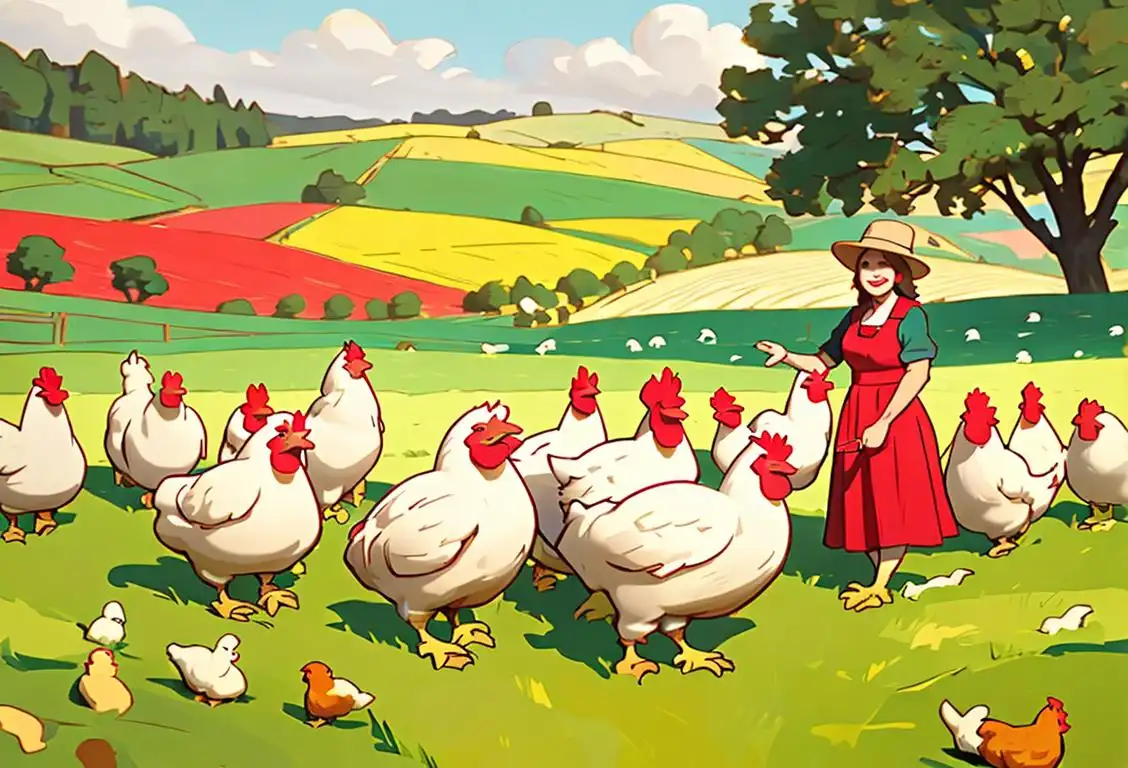National Ovo Day

Get ready to crack some eggs and celebrate because it's National Ovo Day! This egg-citing holiday is all about paying homage to one of nature's most perfect creations - the humble egg. Whether you prefer them scrambled, fried, poached or baked into a delicious cake, there's no denying the versatility and yumminess of this incredible ingredient. So put on your chef's hat and let's dive into the egg-citing world of National Ovo Day!
When is Ovo Day?
It's national ovo day on the 29th July.
The Incredible Egg-citement of National Ovo Day
Did you know that eggs have been a part of human diets for thousands of years? Ancient civilizations in Rome, Egypt, and China all recognized the nutritional value and culinary versatility of eggs. Fast forward to the present day, and eggs continue to be a staple in kitchens all around the world.
So, what makes eggs so egg-ceptional? Well, for starters, they are packed with protein, vitamins, and minerals. They are also a key ingredient in countless dishes, from classic breakfast favorites like omelets and pancakes to mouthwatering desserts like custards and meringues.
And let's not forget the egg-cellent chemistry of eggs! They can bind ingredients together, thicken sauces, and add moisture to baked goods. Without eggs, many beloved recipes would simply fall flat.
Egg-squisite Ways to Celebrate National Ovo Day
1. Have an Egg Buffet: Gather your friends and family for a delicious egg-themed buffet. Serve up an array of egg dishes, from deviled eggs and quiches to egg salad sandwiches and egg fried rice. Let your creativity take flight!
2. Egg Decorating: Get artistic with eggs! Paint them, dye them, or get fancy with intricate designs. Egg decorating is a fun and creative activity that both kids and adults can enjoy.
3. Egg Toss: Embrace your competitive side and organize an egg toss competition. See who can catch and throw an egg without it breaking. Just make sure to have some paper towels handy!
Did You Know?
Did you know that the largest omelet ever made weighed a whopping 6.466 tons? That's a lot of eggs! This mammoth omelet was cooked in Portugal on February 11, 2012, and it took 55 cooks and 145,000 eggs to make. Now that's some serious egg-straordinary dedication to National Ovo Day!
History behind the term 'Ovo'
14th century
Medieval Latin Roots
The term 'ovo' has its roots in medieval Latin. It is derived from the Latin word 'ovum' which means 'egg'. The Latin language was widely spoken during the Middle Ages and had a significant influence on various European languages.
1777
Ancient Origins
The term 'ovo' finds its roots in Latin, specifically in the word 'ovum,' which means 'egg.' Ancient Romans often used the term 'ovum' to refer to eggs, both for poultry and other animals. Eggs have long been regarded as a symbol of new life and fertility in various cultures, making the term 'ovo' significant.
12th century
Ancient Origins
The term 'ovo' traces its roots back to the 12th century in Latin, where it means 'egg'. In Latin, the word 'ovo' had a powerful symbolism associated with life, fertility, and new beginnings.
14th century
Old English Origins
The term 'ovo' finds its origins in Old English, where it was derived from the Old English word 'ōfewe' which meant 'egg'. This early form of the term laid the foundation for the development of various related words across different languages over the centuries.
15th century
Medieval Origin
The term 'ovo' originated in the 15th century in Italy. It comes from the Italian word 'uovo,' which means 'egg.' In medieval times, eggs were considered a symbol of fertility and rebirth, and they featured prominently in various religious and cultural festivities. The term 'ovo' was used to describe events and traditions associated with eggs.
14th century
The Culinary Origins
In the 14th century, the term 'ovo' had its humble beginnings in culinary culture. Derived from the Latin word 'ovum' meaning 'egg', 'ovo' became synonymous with dishes and recipes that incorporate eggs as a key ingredient. Eggs were highly valued for their nutrition and versatility, and thus, the term 'ovo' started to gain popularity in the culinary world.
1440
The Birth of 'Ovo'
The term 'ovo' originates from the Latin word 'ovum', which means egg. It is believed to have been derived from the Latin phrase 'Ovum-vero-optatum', which roughly translates to 'Oh, what a desired egg!' During the 15th century, this phrase was shortened to 'Ovum-vero', and eventually morphed into the term 'ovo' that we use today.
17th century
The Birth of Ovo
The term 'ovo' originates from the Latin word 'ovum' meaning 'egg'. In the 17th century, European explorers encountered various indigenous cultures in South America that had a longstanding tradition of using the term 'ovo' to refer to eggs. This term eventually found its way into the English language, signifying the culinary and symbolic significance of eggs.
14th century
Early origins
The term 'ovo' can be traced back to the 14th century when it first appeared in Italian as a shortened form of the word 'uovo,' meaning 'egg.' In Italian, 'uovo' evolved from the Latin word 'ovum,' which also means 'egg.' The ancient Romans used 'ovum' to refer to the eggs of any creature.
1989
The birth of the Ovo sound
In 1989, the term 'ovo' was first introduced to the world of music with the formation of the Ovo Sound record label in Toronto, Canada. Co-founded by rapper Drake, producer Noah '40' Shebib, and Oliver El-Khatib, Ovo Sound quickly became synonymous with a unique blend of R&B, hip hop, and alternative genres.
14th Century
The Earliest Mention
The term 'ovo' first appears in the Italian language in the 14th century. Derived from the Latin word 'ovum' meaning 'egg', 'ovo' refers to anything egg-related, such as dishes, ingredients, or even shape. Its usage was initially limited to culinary contexts.
16th century
Italian Renaissance
During the Italian Renaissance, the term 'ovo' became more commonly used in Italian. Italian artists and scholars embraced the classical traditions of Ancient Rome and Greece, leading to the revival of Latin terms, including 'ovo'.
15th Century
Symbolism in Art
By the 15th century, 'ovo' gained importance beyond the kitchen. Italian artists, particularly during the Renaissance, started incorporating symbolic representation of eggs in their artworks. Eggs were used to symbolize fertility, new beginnings, and even the cycle of life.
19th century
Culinary Usage
The term 'ovo' gained popularity in the 19th century when it began to appear in recipes and culinary contexts. The Latin-derived term was used to describe dishes or ingredients that contain or focus on eggs. For instance, 'ovo-lacto vegetarianism' refers to a type of vegetarianism that includes eggs and dairy products in the diet.
Late 16th century
Latin Influence
In the late 16th century, the Latin term 'ovum' meaning 'egg' influenced the evolution of the term 'ovo'. This Latin influence expanded the usage of 'ovo' beyond the boundaries of Old English and connected it to the broader European linguistic heritage.
2011
OVOXO collaboration
In 2011, Drake collaborated with fellow Canadian singer The Weeknd on a mixtape called 'OVOXO.' This collaboration not only strengthened the use of the term 'ovo' as an identifier for Drake's music and brand, but it also solidified the OVOXO movement, representing the unity between the two artists and their respective crews.
16th century
Italian Renaissance
During the Italian Renaissance in the 16th century, the term 'ovo' gained prominence in the culinary world. Italian gastronomes started using it to describe dishes that heavily featured eggs, such as omelettes and frittatas.
16th century
Culinary significance
During the Renaissance period, gastronomy flourished, and Italian cuisine gained widespread popularity. The term 'ovo' found a special place in culinary circles as a prefix to describe dishes and ingredients made with or containing eggs. The versatility of eggs in cooking led to the development of various 'ovocentric' recipes that are still cherished today, such as 'frittata,' 'tiramisu,' and 'carbonara.'
1650
The Cultural Symbolism
In the 17th century, the term 'ovo' started to gain cultural significance and became associated with fertility, new beginnings, and the potential for growth. Eggs are often seen as a symbol of life and rebirth in many cultures around the world. 'Ovo' became a word used to express anticipation and excitement for what the future holds, much like the hopes and expectations associated with a freshly laid egg.
18th century
The Evolution of Ovo
During the 18th century, 'ovo' evolved beyond its culinary connotations and began to be used in a broader context. It made its way into scientific literature as a prefix, signifying anything related to eggs. Additionally, it became associated with studies and research conducted in the field of embryology, as eggs play a crucial role in the development of various organisms.
18th century
Royal Ballet Influence
During the 18th century, the term 'ovo' gained popularity due to its association with ballet. The Royal Ballet in London premiered the ballet 'Ovo' in 1762. The performance was a resounding success, and it featured dancers dressed as insects, portraying a colorful and imaginative world. This ballet not only introduced 'ovo' into the vocabulary of dance enthusiasts but also helped to popularize the term among the general public.
19th century
Ovo in British English
During the 19th century, the term 'ovo' gained popularity in British English, primarily due to the influence of culinary traditions. British chefs embraced the French term 'oeufs' meaning 'eggs', which then gradually merged with the native English word 'eggs'. As a result, the word 'ovo' became an alternative, albeit less common, way of referring to eggs.
20th century
Ovos Moles and Portuguese Influence
In the early 20th century, an intriguing culinary treat called 'ovos moles' emerged in Portugal. These sweet egg-based delicacies shaped like shells became popular and contributed to the cultural significance of 'ovo' in the Portuguese language. The term 'ovo' expanded its connotations beyond the simple noun 'egg' and became associated with sweet treats and desserts.
2015
The notorious OVO owl
The OVO owl logo, designed by Filip Pagowski, gained significant recognition and became an iconic symbol in popular culture. The owl represents wisdom, power, and the nocturnal nature of Drake's music. It is now widely associated with the OVO brand and can be seen on merchandise, album covers, and promotional materials.
19th century
Ovo-Lacto Vegetarianism
During the 19th century, the term 'ovo' gained significance in the dietary context. Specifically, it became an essential component in the classification of vegetarianism. In particular, 'ovo-lacto vegetarianism' emerged as a dietary practice that permits the consumption of eggs and dairy products while abstaining from meat.
19th century
Symbolism in art and literature
In the 19th century, the term 'ovo' began to acquire symbolic connotations in art and literature. Artists and writers found inspiration in the egg's shape, form, and potential for new life, using it as a metaphor for creation, rebirth, and the human condition. The iconic painting 'The Birth of Venus' by Sandro Botticelli, featuring the goddess emerging from a giant seashell, exemplifies this symbolism.
20th century
Symbol of Creativity
In the 20th century, 'ovo' started to be associated with creativity and innovation. Artists, writers, and designers began using 'ovo' as a metaphor for originality and inspiration. The term represented the birth of new ideas and the emergence of unique artistic expressions. Its usage in this context became more prevalent and helped solidify 'ovo' as a symbol of creativity.
18th Century
The Ovo Globe
In the 18th century, a peculiar variation of the term 'ovo' emerged. The 'ovo globe' was a decorative object, typically made of glass, with a hollow center and various scenes or landscapes suspended inside. These globes were intricately designed and often showcased miniature landscapes, buildings, or even figurines.
1956
OVO: A Cultural Phenomenon
In 1956, the artist Yoko Ono coined the term 'OVO' as a play on the word 'ovum.' Yoko Ono's use of 'OVO' represented the idea of breaking barriers and embracing creativity. It became associated with her avant-garde art and musical experiments, creating a cultural phenomenon around the term.
17th century
Expansion of the Term
In the 17th century, the term 'ovo' gained wider usage and recognition beyond the Italian language. With the flourishing of trade and cultural interactions among European nations, various languages borrowed the term, adapting it into their own vocabulary.
20th century
Ovo in Music and Arts
The 20th century witnessed the term 'ovo' making its mark in the realms of music and arts. In 1916, Igor Stravinsky composed a captivating ballet titled 'L'Oiseau de feu' (The Firebird), where 'ovo' represented the mythical bird's egg. This ballet achieved immense popularity and contributed to the broader recognition and usage of the term 'ovo' in artistic expressions.
19th century
The Ovo-Lacto Vegetarian Movement
In the 19th century, with the rise of vegetarianism as a philosophical movement, the term 'ovo' found its way into dietary practices. Ovo-lacto vegetarians, who consume eggs and dairy products but avoid meat, adopted this term to describe their chosen lifestyle.
1920
Ovo in Popular Culture
With the rise of cinema and mass media in the 20th century, the term 'ovo' began to be used in popular culture. It was often used in advertisements, movie titles, and catchphrases to evoke a sense of mystery and allure. The term entered the lexicon of popular culture and became a trendy term to describe something intriguing or enigmatic.
21st century
Cultural Phenomenon
In the 21st century, 'ovo' expanded its cultural impact through the global success of a touring circus show called 'OVO.' Created by Cirque du Soleil, 'OVO' showcased breathtaking acrobatics and stunning visuals, drawing audiences from all around the world. The unique title added to the show's intrigue, and it further popularized the term 'ovo' in mainstream culture. Today, 'ovo' is often associated with excitement, wonder, and the captivating world of performance arts.
19th Century
Ovoscopy and Predictions
During the 19th century, the practice of ovoscopy became popular. This divination method involved examining the shape, size, and other characteristics of an egg to predict the future. Ovoscopy was adopted by various cultures, including Italian and Irish communities, and continues to be practiced by some people today.
21st century
Ovo in Popular Culture
In recent years, the term 'ovo' has gained further recognition through popular culture references. One notable example is the Canadian rapper Aubrey Drake Graham, who adopted the nickname 'Drake' which originates from his middle name. Drake is known for his record label 'OVO Sound' (October's Very Own), which has expanded his influence beyond music and into fashion and lifestyle. With its unique blend of meanings, 'ovo' continues to shape the cultural landscape, representing not only eggs but also creativity, entrepreneurship, and success.
2016
OVO Fest takes the stage
OVO Fest, an annual music festival, was established by Drake in 2010 but gained immense popularity in 2016. Held in Toronto, the festival showcases not only Drake's talent but also features performances by renowned artists. OVO Fest has become a celebration of Toronto's vibrant music scene and a prominent event in the entertainment calendar.
21st century
The Rise of OVO and Popular Culture
In the 21st century, the abbreviation 'OVO' gained significant attention through the notable Canadian rapper, Drake. He founded a record label called 'October's Very Own (OVO)' in 2012, with 'October' referring to his birth month and 'OVO' derived from his tattoo of an owl, which symbolizes his wisdom and observance. OVO became highly influential in the music industry and expanded its influence into fashion, becoming a recognized brand worldwide.
20th century
Integration into Popular Culture
In the 20th century, the term 'ovo' found its way into popular culture, particularly in the culinary world. 'Ovo' became associated with dishes, recipes, and products containing or primarily made from eggs. From omelettes to pastries, 'ovo' became a recognized term in gastronomy.
20th century
Ovoscope and modern references
As advancements in technology and science continued, the 20th century saw the development of the 'ovoscope,' a device used to examine the interior characteristics of an egg without breaking the shell. This invention revolutionized poultry farming and contributed to the understanding of egg quality and fertility. Additionally, the term 'ovo' gained popularity in modern culture through musical references such as the hit song 'Ovo je Balkan' by Serbian singer Milan Stanković.
20th century
Symbolic Icon
In the 20th century, 'ovo' took on a symbolic role within creative and artistic fields. For instance, the term became associated with the avant-garde art movement known as 'OVO', founded by Isidoro Isou in 1942 in Romania. This movement sought to challenge the established norms of art and cinema and aimed to redefine the boundaries of artistic expression.
2020
Modern Usage and Memes
In recent years, 'ovo' has found a new life in internet culture. Memes and online communities have embraced the term as a shorthand for anything clever, ingenious, or unexpected. For example, when something surprises or impresses someone, they may use the phrase 'Ovo, that's egg-cellent!' as a playful way to express their appreciation. 'Ovo' has become embedded in the digital lexicon as a symbol of creativity and delight.
20th century
Symbol of Birth and Rebirth
In the 20th century, the symbolism of 'ovo' expanded beyond its culinary and dietary associations. It became synonymous with birth, rebirth, and the circle of life. The eggshell's delicate yet protective nature represented the fragility and resilience of life itself.
2009
OVO: Cirque du Soleil
In 2009, Cirque du Soleil, the renowned Canadian circus and entertainment company, premiered their show 'OVO.' The show, directed by Deborah Colker, revolves around the idea of a vibrant ecosystem filled with insects and their mysterious eggs ('ovos'). Cirque du Soleil's 'OVO' brought the term to a broader audience, associating it with mesmerizing acrobatics, music, and visual storytelling.
2020
OVO transcends music
Over the years, OVO has evolved to become more than just a record label. It has expanded into a full-fledged lifestyle brand encompassing fashion, merchandise, and collaborations with major companies. OVO has collaborated with companies like Nike, Jordan Brand, and Canada Goose, making it a prominent player in the world of streetwear and luxury fashion.
21st century
Drake's OVO Sound
In the 21st century, the term 'ovo' gained wider recognition through the cultural impact of Canadian rapper Drake. In 2012, Drake launched his own record label called OVO Sound, where 'OVO' stands for 'October's Very Own,' referencing Drake's birth month. The OVO Sound label became not only a platform for Drake's music but also a cultural phenomenon, helping to popularize the term 'ovo' among a global audience.
21st century
Ovotarian lifestyle
In recent years, the term 'ovo' has found relevance in dietary choices and lifestyles. Individuals who follow an 'ovotarian' diet primarily consume plant-based foods, along with eggs, as a source of protein. This dietary pattern has gained attention for its potential health benefits, sustainability, and ethical considerations. The term 'ovo' continues to evolve and adapt to the changing cultural and gastronomic landscape.
20th Century
Egg as a Design Symbol
In the 20th century, the term 'ovo' received a renewed cultural significance. Designers and artists started incorporating egg-shaped elements in multiple fields, including architecture, furniture, and product design. The smooth and simple shape of an egg became a symbol of elegance, purity, and modernity.
Present Day
Pop Culture and Marketing
Today, the term 'ovo' has permeated popular culture and marketing. It often appears in brand names, album titles, and even clothing lines. The cultural impact of 'ovo' continues to evolve, capturing people's attention and curiosity. It serves as a reminder of the term's historical significance and the diverse ways it has been embraced across different fields of creativity.
1969
The Beatles' 'Abbey Road' Album
The term 'ovo' gained pop culture recognition in 1969 with the release of The Beatles' iconic album, 'Abbey Road.' The album cover features a zebra crossing, and the Volkswagen Beetle in the background bears a license plate reading '28 IF,' which has been interpreted as a reference to Paul McCartney supposedly being 28 years old if he were alive. Some fans misread the '28 IF' as 'Sgt. OVO,' leading to the term becoming associated with The Beatles' legacy.
21st Century
Popularization through Technology
With the advent of technology and social media, the term 'ovo' has found new avenues of popularity in the 21st century. 'Ovo' became widely recognized as the name of a well-known company established by the Canadian musician, Drake. This further increased the visibility and usage of the term in popular culture.
21st century
Drake's OVO Sound Label
In the 21st century, the term 'ovo' gained a new significance through Drake, the Canadian rapper. Drake's record label, OVO Sound, founded in 2012, popularized the term globally. OVO stands for 'October's Very Own,' referencing Drake's birth month and representing his personal brand.
Did you know?
Did you know that the largest omelet ever made weighed a whopping 6.466 tons? That's a lot of eggs!Tagged
nsfw food funFirst identified
29th July 2015Most mentioned on
29th July 2015Total mentions
149Other days
Chocolate Mousse Day
Something On A Stick Day
Children Day
Awareness Day
Frappe Day
Taco And Vodka Day
Happiness Day
Opposite Day
One Day
Poultry Day









